Papers by Nawal Al Musayeib

Copyright © 2013 Mohammed Al-Yahya et al. This is an open access article distributed under the Cr... more Copyright © 2013 Mohammed Al-Yahya et al. This is an open access article distributed under the Creative Commons Attribution License, which permits unrestricted use, distribution, and reproduction in any medium, provided the original work is properly cited. The present study was undertaken to investigate the possible protective effect of Saudi Sidr honey (SSH) on carbon tetrachloride (CCl 4) induced oxidative stress and liver and kidney damage in rat. Moreover, the antioxidant activity and the phenolic and flavonoidal contents were determined. The hepatorenal protective activity of the SSH was determined by assessing biochemical, hematological, and histological parameters. Serum transaminases, ALP, GGT, creatinine, bilirubin urea, uric acid, and MDA level in liver and kidney tissues were significantly elevated, and the antioxidant status of nonprotein sulfhydryls, albumin, and total protein levels in liver and kidney were declined significantly in CCl 4 alone treated animals. Pretrea...

Phytochemistry Letters, 2014
ABSTRACT Two new fusicoccane diterpenes hypoestenonols A (1) and B (2), along with two known comp... more ABSTRACT Two new fusicoccane diterpenes hypoestenonols A (1) and B (2), along with two known compounds verticillarone (3) and hypoestenone (4) were isolated from the n-hexane fraction of the methanolic extract of the aerial parts of Hypoestes forskalei (Acanthaceae) growing in Saudi Arabia. The tructures were established by UV, IR, HRESIMS, 1D (1H and13C NMR) and 2D (1H–1H COSY, HSQC, MBC, and NOESY) NMR experiments, in addition to comparison with literature data. The total MeOH extract and isolated compounds were tested for their antiprotozoal and cytotoxic activities. The MeOH extract showed moderate activity against Plasmodium falciparum, Leishmania infantum, Trypanosoma cruzi, and Trypanosoma brucei with IC50values of 8.8, 8.1, 9.1 and 8.1 mg/mL without cytotoxicity (IC50>64 mg/mL on MRC5cells). A very weak in vitro antiplasmodial effect was observed for hypoestenonol A (1) (IC5018.9 mM), verticillarone (3) (IC5025.1 mM), and hypoestenone (4) (IC5016.7 mM).
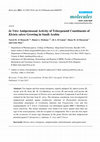
Molecules, 2013
Two lupane and four ursane triterpenes, namely epilupeol (1), lupeol acetate (2), ursolic acid (3... more Two lupane and four ursane triterpenes, namely epilupeol (1), lupeol acetate (2), ursolic acid (3), brein (4), 3β 11α-dihydroxy urs-12-ene (5) and ursolic acid lactone (6) were isolated from aerial parts of Kleinia odora and identified. Compounds 1 and 3-6 were isolated for the first time from K. odora. The triterpene constituents were investigated for antiprotozoal potential against erythrocytic schizonts of Plasmodium falciparum, intracellular amastigotes of Leishmania infantum and Trypanosoma cruzi and free trypomastigotes of T. brucei. Cytotoxicity was determined against MRC-5 fibroblasts to assess selectivity. The ursane triterpenes were found to be active against more than one type of the tested parasites, with the exception of compound 6. This is also the first report on the occurrence of ursane type triterpenes in the genus Kleinia and their antiprotozoal potential against P. falciparum, L. infantum, T. cruzi, and T. brucei.
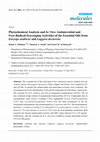
Molecules, 2011
The essential oils of the aerial part of two Asteraceae species, namely Euryops arabicus Steud. a... more The essential oils of the aerial part of two Asteraceae species, namely Euryops arabicus Steud. and Laggera decurrens (Vahl.) Hepper and Wood, were studied by GC and GC/MS. In parallel the antimicrobial and antioxidant activities were evaluated. The investigation led to the identification of 48 and 44 compounds for both plants, respectively. The essential oil of E. arabicus was rich in oxygenated sesquiterpenes (39.9%). The oil also contained a high content of sesquiterpene hydrocarbons (24.1%). Compounds such as caryophyllene oxide (8.6%), T-cadinol (7.0%), spathulenol (5.2%), (E)-β-caryophyllene (6.0%) and 2-epi-(E)-β-caryophyllene (6.0%) were the main constituents of the oil. Oxygenated monoterpenes also predominated in L. decurrens (46.3%). The thymoquinonederivative, 3-methoxy-2-methyl-5-(1-methylethyl)-2,5-cyclohexadiene-1,4-dione (28.1%), thymol (5.7%) and eudesma-11-en-4a-ol (7.0%) were the most abundant constituents. Both essential oils showed antimicrobial activity with MIC-values between 0.13-5.25 mg/mL. Furthermore, only the essential oil of L. decurrens exhibited a strong antioxidant activity (91%) at 500 µg/mL.
Molecules, 2013
Five xanthone derivatives and one flavanol were isolated from the dichloromethane extract of Garc... more Five xanthone derivatives and one flavanol were isolated from the dichloromethane extract of Garcinia mangostana. Dichloromethane, ethyl acetate extract and the major xanthone (α-mangostin) were evaluated in vitro against erythrocytic schizonts of Plasmodium falciparum, intracellular amastigotes of Leishmania infantum and Trypanosoma cruzi and free trypomastigotes of T. brucei. The major constituent α-mangostin was also checked for antimicrobial potential against Candida albicans, Escherichia coli, Pseudomonas aeruginosa, Bacillius subtilis, Staphylococcus aureus, Mycobacterium smegmatis, M. cheleneoi, M. xenopi and M. intracellulare. Activity against

Journal of Medicinal Plants Research, 2012
Leishmaniasis is a group of diseases caused by protozoa of the genus Leishmania. This major world... more Leishmaniasis is a group of diseases caused by protozoa of the genus Leishmania. This major world health problem ranks among the six most important tropical infectious diseases by the World Health Organization. The current study was undertaken to exploit the antileishmanic activity of three medicinally active plants of Saudi flora, Calotropis procera, Caralluma sinaica and Cordia sinensis using 3-(4,5-dimethylthiazol-2-yl)-5-(3-carboxymethoxyphenyl)-2-(4-sulfophenyl)-2H-tetrazolium (MTS) assay. The highest antileishmanial activity against Leishmania major was exhibited at 200 µg/ml by nhexane fraction of C. sinaica (81.44% inhibition). Meanwhile, approximately 60% inhibition was shown by chloroform, ethyl acetate, n-butanol and aqueous extracts of this plant. C. procera extracts showed lower inhibition potency ranging from 47 to 56% of inhibition, compared to C. sinaica at similar concentration.
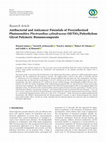
Bioinorganic Chemistry and Applications, 2021
The present study is concerned with the fabrication of the bifunctional Plectranthus cylindraceus... more The present study is concerned with the fabrication of the bifunctional Plectranthus cylindraceus oil/TiO2/polyethylene glycol polymeric film for antibacterial and anticancer activities. The suggested film is based on the utility of naturally extracted P. cylindraceus oil in the formation of the polymeric bionanocomposite film decorated with TiO2 nanoparticles. The bionanocomposite film was fabricated by incorporating 15 w% of P. cylindraceus oil with 10 w% polyethylene glycol and 5 w% TiO2 nanoparticles. The active components of P. cylindraceus oil were verified using gas chromatography coupled with mass spectrometry (GC-MS). The surface morphology of the resulted bionanocomposite film was characterized by various spectroscopic and microscopic techniques. The antibacterial potential of the fabricated bionanocomposite film was investigated against four pathogenic strains. The obtained results revealed excellent sensitivity against the bacterial strains, particularly E. coli and S. a...
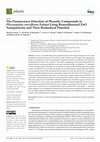
Plants, 2022
A facile, eco-friendly fluorescence approach based on the biogenic formation of zinc oxide nanopa... more A facile, eco-friendly fluorescence approach based on the biogenic formation of zinc oxide nanoparticles using the biomass of Plicosepalus curviflorus shoots was developed. The suggested approach was employed to analyze three phenolic compounds (catechin, curviflorside, and curviflorin) isolated from the shoots of P. curviflorus. The surface morphology of the prepared ZnONPs was characterized by carrying out different microscopic and spectroscopic investigations. A significant UV-Vis absorption peak of ZnONPs was recognized at 345 nm and the FT-IR spectra of the isolated catechin, curviflorside, and curviflorin in the presence of sodium dodecyl sulfate (SDS) and ZnONPs were recorded at λem 470, 490, and 484 nm after excitation at λex 380, 420, and 410 nm. The suggested fluorescence method displayed linear concentration ranges of 10–120, 5–100, and 10–150 μg mL−1 for the three isolated compounds, respectively. The shoot extract, isolated compounds, and ZnONPs were screened for antiba...
<div><p>Two new flavonol glycosides, brachysides C and D, together with three known f... more <div><p>Two new flavonol glycosides, brachysides C and D, together with three known flavonol glycosides, were isolated from the leaves of <i>Caragana brachyantha</i>. The structures of brachysides C and D were elucidated on the basis of detailed spectroscopic analysis as quercetin 5-<i>O</i>-[α-l-rhamnopyranosyl-(1 → 6)-β-d-glucopyranoside]-7-<i>O</i>-[α-l-rhamnopyranoside] and quercetin 5-<i>O</i>-[α-l-rhamnopyranosyl-(1 → 6)-β-d-glucopyranoside]-7-<i>O</i>-[α-l-rhamnopyranoside]-4′-<i>O</i>-[α-l-rhamnopyranoside], respectively. The presence of flavonol tetra- and triglycosides bearing a sugar moiety at position 5 was the first report from this genus <i>Caragana</i>.</p></div

Polymers, 2021
A unique morphological Sesamum radiatum oil/polyvinylpyrrolidone/gold polymeric bionanocomposite ... more A unique morphological Sesamum radiatum oil/polyvinylpyrrolidone/gold polymeric bionanocomposite film was synthesized using the S. radiatum oil dispersed in a polymeric polyvinylpyrrolidone (PVP) matrix and decorated with gold nanoparticles (AuNPs). The chemical and physical characteristics as well as the thermal stability of the synthesized bionanocomposite film were investigated using various spectroscopic and microscopic techniques. The microscopic analysis confirmed well dispersed AuNPs in the PVP- S. radiatum oil matrix with particle size of 100 nm. Immunomodulatory and antiprotozoal potentials of the suggested bionanocomposite film were evaluated for lipopolysaccharide-induced BV-2 microglia and against L. amazonensis, L. mexicana promastigotes and T. cruzi epimastigotes, respectively. The results exerted outstanding reduction of inflammatory cytokines’ (IL-6 and TNFα) secretions after pretreatment of bionanocomposite. The bionanocomposite exhibited large inhibitory effects on...

Biomedical Research-tokyo, 2017
A series of 3, 5-disubstituted-4, 5-dihydro-1H-pyrazoles have been synthesized under solvent free... more A series of 3, 5-disubstituted-4, 5-dihydro-1H-pyrazoles have been synthesized under solvent free microwave irradiation method by the condensation of α, β-unsaturated ketones with hydrazine and its differently substituted derivatives. The chemical structures of the compounds were characterized by elemental analysis and spectroscopic data. All the synthetics were evaluated for their anti-inflammatory activity under in vivo conditions. The present study describes the potential of these pyrazole ring containing scaffolds to assess the TNF α (Tumor Necrosis Factor-alpha) and IL-1β (Interleukin-1 beta) inhibitory potential. TNF-α and IL-1β are inflammatory cytokines that are pro-inflammatory in nature and play a major role in inflammatory cascades of many pathologically dreadful diseases ranging from neurodegenerative disorders to autoimmune diseases such as rheumatoid arthritis.

Scientific Reports, 2021
Excess glutamate in the central nervous system may be a major cause of neurodegenerative diseases... more Excess glutamate in the central nervous system may be a major cause of neurodegenerative diseases with gradual loss and dysfunction of neurons. Primary or secondary metabolites from medicinal plants and algae show potential for treatment of glutamate-induced excitotoxicity. Three plant extracts were evaluated for impact on glutamate excitotoxicity-induced in primary cultures of retinal ganglion cells (RGC). These cells were treated separately in seven groups: control; Plicosepalus. curviflorus treated; Saussurea lappa treated; Cladophora glomerate treated. Cells were treated independently with 5, 10, 50, or 100 µg/ml of extracts of plant or alga material, respectively, for 2 h. Glutamate-treated cells (48 h with 5, 10, 50, or 100 µM glutamate); and P. curviflorus/glutamate; S. lappa/glutamate; C. glomerata/glutamate [pretreatment with extract for 2 h (50 and 100 µg/ml) before glutamate treatment with 100 µM for 48 h]. Comet and MTT assays were used to assess cell damage and cell via...
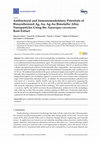
Nanomaterials, 2020
Two noble metals, such as silver and gold alloy nanoparticles, were successfully synthesized by t... more Two noble metals, such as silver and gold alloy nanoparticles, were successfully synthesized by the microwave assisted method in the presence of the Asparagus racemosus root extract and were used as an antibacterial and immunomodulatory agent. The nanostuctures of the synthesized nanoparticles were confirmed by various spectroscopic and microscopic techniques. The UV-vis spectrum exhibits a distinct absorption peak at 483 nm for the bimetallic alloy nanoparticles. The microscopic analysis revealed the spherical shaped morphology of the biosynthesized nanoparticles with a particle size of 10–50 nm. The antibacterial potential of the green synthesized single metal (AgNPs and AuNPs) and bimetallic alloy nanoparticles was tested against five bacterial strains. The bimetallic alloy nanoparticles displayed the highest zone of inhibition against P. aeurgnosia and S.aureus strains when compared to single metal nanoparticles and plant extract. In addition, the inmmunomodulatory potential of ...
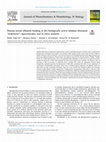
Journal of photochemistry and photobiology. B, Biology, 2018
Labdane diterpenes are important substances due to their remarkable biological activities such as... more Labdane diterpenes are important substances due to their remarkable biological activities such as, antibacterial, antiprotozoal, antifungal and cytostatic and cytotoxic effects against human cancer cells. We have isolated a labdane diterpene named "leoheterin" from the aerial parts of the Otostegia fruticosa Forssk (Briq) obtained from south west Arabian mountains of Saudi Arabia. The isolated compound was characterized by HNMR, CNMR, IR and UV-visible spectroscopies. Due to the pharmaceutical importance of this class of compounds we have studied the interaction of HSA with leoheterin by using several spectroscopic methods. The change in the UV spectrum of HSA in presence of leoheterin gives a primary idea about the interaction between them. Congruently, leoheterin quenches the fluorescence of HSA with a prominent blue shift of 5 nm, reminiscent of involvement of hydrophobic interactions. There was 1:1 binding between leoheterin and albumin which was taken place via static...
Zeitschrift für Naturforschung C, 2017
The naphthalene glycosidecurviflorside [1,5-dihydroxy-8-methoxynaphthalene-2-

Luminescence : the journal of biological and chemical luminescence, Jan 15, 2016
A sipholane triterpenoid, named sipholenone A, with anti-cancer properties was isolated from the ... more A sipholane triterpenoid, named sipholenone A, with anti-cancer properties was isolated from the Red Sea sponge Siphonochalina siphonella and characterized by proton and carbon-13 nuclear magnetic resonance ((1) H NMR and (13) C NMR) spectroscopies. The goal of this study was to visualize the binding of this triterpenoid with human serum albumin (HSA) and to determine its binding site on the biomacromolecule. The interaction was visualized using fluorescence quenching, synchronous fluorescence, far- and near-UV circular dichroism (CD), UV-visible and Fourier transform-infrared (FT-IR) spectroscopies. UV-visible spectroscopy indicated the formation of a ground-state complex as a result of the interaction. Sipholenone A quenches the fluorescence of HSA via a static quenching mechanism. A small blue shift in the fluorescence quenching profiles suggested the involvement of hydrophobic forces in the interaction. Sipholenone A binding takes place at site I of subdomain II A with a 1:1 bin...

Natural Product Research, 2014
Two new flavonol glycosides, brachysides C and D, together with three known flavonol glycosides, ... more Two new flavonol glycosides, brachysides C and D, together with three known flavonol glycosides, were isolated from the leaves of Caragana brachyantha. The structures of brachysides C and D were elucidated on the basis of detailed spectroscopic analysis as quercetin 5-O-[α-l-rhamnopyranosyl-(1 → 6)-β-d-glucopyranoside]-7-O-[α-l-rhamnopyranoside] and quercetin 5-O-[α-l-rhamnopyranosyl-(1 → 6)-β-d-glucopyranoside]-7-O-[α-l-rhamnopyranoside]-4&amp;amp;amp;amp;amp;amp;amp;amp;amp;amp;amp;amp;amp;amp;amp;amp;amp;amp;amp;amp;amp;amp;amp;amp;amp;amp;amp;amp;amp;amp;amp;amp;amp;amp;amp;amp;amp;amp;amp;amp;amp;amp;amp;amp;amp;amp;amp;amp;amp;amp;amp;amp;amp;amp;amp;amp;amp;amp;amp;amp;amp;amp;amp;amp;amp;amp;amp;amp;amp;amp;amp;amp;amp;amp;amp;amp;amp;amp;amp;amp;amp;amp;amp;amp;amp;amp;amp;amp;amp;amp;amp;amp;amp;amp;amp;amp;amp;amp;amp;amp;amp;amp;amp;amp;amp;amp;amp;amp;amp;amp;amp;amp;amp;amp;amp;amp;amp;amp;amp;amp;amp;amp;amp;amp;amp;amp;amp;amp;amp;amp;amp;amp;amp;amp;amp;amp;amp;amp;amp;amp;amp;amp;amp;amp;amp;amp;amp;amp;amp;amp;amp;amp;amp;amp;amp;amp;amp;amp;amp;amp;amp;amp;amp;amp;amp;amp;amp;amp;amp;amp;amp;amp;amp;amp;amp;amp;amp;amp;amp;amp;amp;amp;amp;amp;amp;amp;amp;amp;amp;amp;amp;amp;amp;amp;amp;amp;amp;amp;amp;amp;amp;amp;amp;amp;amp;amp;amp;amp;amp;amp;amp;amp;amp;amp;amp;amp;amp;amp;amp;amp;amp;amp;amp;amp;amp;amp;amp;amp;amp;amp;amp;amp;amp;amp;amp;amp;amp;amp;amp;amp;amp;amp;amp;amp;amp;amp;amp;amp;amp;amp;amp;amp;amp;amp;amp;amp;amp;amp;amp;amp;amp;amp;amp;amp;amp;amp;amp;amp;amp;amp;amp;amp;amp;amp;amp;amp;amp;amp;amp;amp;amp;amp;amp;amp;amp;amp;amp;amp;amp;amp;amp;amp;amp;amp;amp;amp;amp;amp;amp;amp;amp;amp;amp;amp;amp;amp;amp;amp;amp;amp;amp;amp;amp;amp;amp;amp;amp;amp;amp;amp;amp;amp;amp;amp;amp;amp;amp;amp;amp;amp;amp;amp;amp;amp;amp;amp;amp;amp;amp;amp;amp;amp;amp;amp;amp;amp;amp;amp;amp;amp;amp;amp;amp;amp;amp;amp;amp;amp;amp;amp;amp;amp;amp;amp;amp;amp;amp;amp;amp;amp;amp;amp;amp;amp;amp;amp;amp;amp;amp;amp;amp;amp;amp;amp;amp;amp;amp;amp;amp;amp;amp;amp;amp;amp;amp;amp;amp;amp;amp;amp;amp;amp;amp;amp;amp;amp;amp;amp;amp;amp;amp;amp;amp;amp;amp;amp;amp;amp;amp;amp;amp;amp;amp;amp;amp;amp;amp;amp;amp;amp;amp;amp;amp;amp;amp;amp;amp;amp;amp;amp;amp;amp;amp;amp;amp;amp;amp;amp;amp;amp;amp;amp;amp;amp;amp;amp;amp;amp;amp;amp;amp;amp;amp;amp;amp;amp;amp;amp;amp;amp;amp;amp;amp;amp;amp;amp;amp;amp;amp;amp;amp;amp;amp;amp;amp;amp;amp;amp;amp;amp;amp;amp;#39;-O-[α-l-rhamnopyranoside], respectively. The presence of flavonol tetra- and triglycosides bearing a sugar moiety at position 5 was the first report from this genus Caragana.
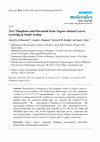
Molecules, 2014
Phytochemical investigation of the methanolic extract of Tagetes minuta L. (Asteraceae) leaves re... more Phytochemical investigation of the methanolic extract of Tagetes minuta L. (Asteraceae) leaves resulted in the isolation and identification of two new compounds: 5-methyl-2,2',5',2'',5'',2''',5''',2''''-quinquethiophene (1) and quercetagetin-6-O-(6-Ocaffeoyl-β-D-glucopyranoside) (9), in addition to seven known compounds: quercetin-3,6dimethyl ether (2), quercetin-3-methyl ether (3), quercetin (4), axillarin-7-O-β-Dglucopyranoside (5), quercetagetin-3,7-dimethoxy-6-O-β-D-glucopyranoside (6), quercetagetin-7-methoxy-6-O-β-D-glucopyranoside (7), and quercetagetin-6-O-β-Dglucopyranoside (8). The compounds were identified by UV, IR, 1D, 2D NMR, and HRESIMS spectral data. They showed significant antioxidant activity, comparable with that of propyl gallate. Compounds 8 and 3 showed weak to moderate antileishmanial and antimalarial activities, with IC 50 values of 31.0 μg/mL and 4.37 μg/mL, respectively.
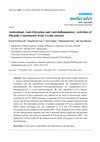
Molecules, 2011
Nine compounds have been isolated from the ethyl acetate soluble fraction of C. sinensis, namely ... more Nine compounds have been isolated from the ethyl acetate soluble fraction of C. sinensis, namely protocatechuic acid (1), trans-caffeic acid (2), methyl rosmarinate (3), rosmarinic acid (4), kaempferide-3-O-β-D-glucopyranoside (5), kaempferol-3-O-β-Dglucopyranoside (6), quercetin-3-O-β-D-glucopyranoside (7), kaempferide-3-O-α-Lrhamnopyranosyl (1→6)-β-D-glucopyranoside (8) and kaempferol-3-O-α-L-rhamnopyranosyl (1→6)-β-D-glucopyranoside (9), all reported for the first time from this species. The structures of these compounds were deduced on the basis of spectroscopic studies, including 1D and 2D NMR techniques. Compounds 1-9 were investigated for biological activity and showed significant anti-inflammatory activity in the carrageen induced rat paw edema test. The antioxidant activities of isolated compounds 1-9 were evaluated by the DPPH radical scavenging test, and compounds 1, 2, 4 and 7-9 exhibited marked scavenging activity compared to the standard BHA. These compounds were further studied for their anti-glycation properties and some compounds showed significant anti-glycation inhibitory activity. The purity of compounds 2-5, 8 and 9 was confirmed by HPLC. The implications of these results for the chemotaxonomic studies of the genus Cordia have also been discussed.

Journal of Sol-Gel Science and Technology, 2014
Well-organized nanocrystalline hydroxyapatite nanoparticles garlanded poly(DL-lactide-co-glycolid... more Well-organized nanocrystalline hydroxyapatite nanoparticles garlanded poly(DL-lactide-co-glycolide) (PLGA) ultrafine fibers with efficient antibacterial properties are of great interest in the development of new products. In the present study, hydroxyapatite doped PLGA ultrafine fibers incorporated with copper oxide nanocrystals were fabricated via two step methodology. Primarily; copper oxide nanocrystals were synthesized using wet chemical method. Then the as-synthesized nanocrystals were used for the preparation of composite fibers using electrospinning technique. The properties of pure and composite ultrafine fibers were characterized using X-ray diffraction, scanning electron microscopy, energy dispersive X-ray analysis, and electron probe mapping analysis. The in vitro antimicrobial activity of synthesized pure and hydroxyapatite doped PLGA ultrafine fibers was investigated against model organism Escherichia coli (gram negative) using optical density method and morphological damage was observed by TEM. Ultrafine fibers with average diameter ranges from 1.0 to 1.2 lm were obtained. Uniform distribution of hydroxyapatite was observed. Admirable antimicrobial activity against E. coli was achieved which could be attributed by the synergy between hydroxyapatite and copper oxide. In contrast to pristine PLGA, lower concentrations of hydroxyapatite-copper oxide doped PLGA nanocomposite were needed to strongly inhibit the growth of E. coli. Our results report successful preparation of hydroxyapatite-copper oxide based novel nanocomposite. The developed hybrid nanocomposite possess exceptionally good antibacterial activity against E. coli due to the synergistic effect of hydroxyapatite and copper oxide. The antimicrobial nanocomposite can be utilized for a range of bio-functional purposes such as a good candidate for water purification, antibiofouling, wound dressings and bone tissue engineering etc.










Uploads
Papers by Nawal Al Musayeib